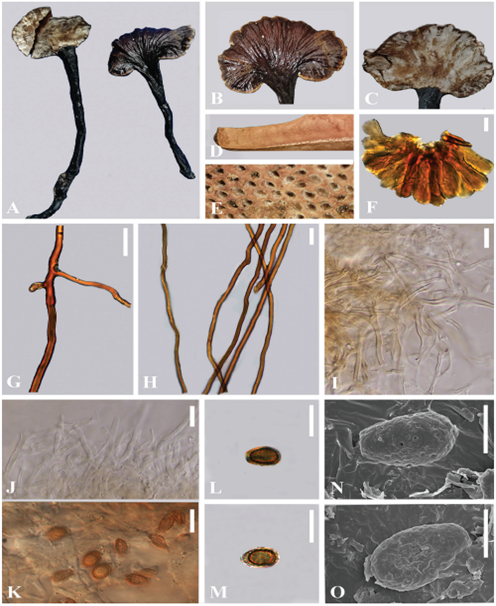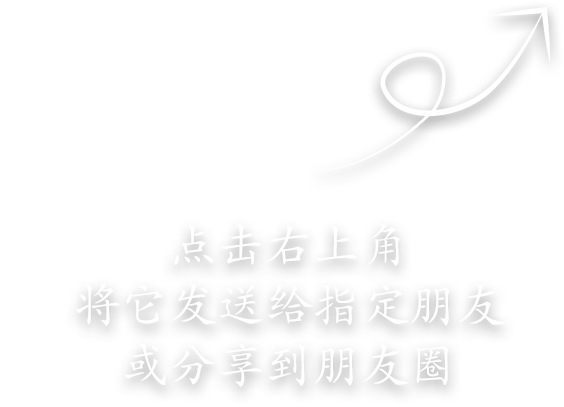 139
139
Ganoderma esculentum J. He & S.H. Li, sp. nov. 2021
Fungorum number: 558823
MycoBank No: 841409
Holotype. China. Yunnan Province, Honghe City, Mengzi County, on a decaying wood log, alt. 1370 m, Jun He, 26 Aug., 2019, L4935 (HKAS 110006).
Morphological description :
Asexual morph: Basidiomata annual, stipitate, pleuropodal, laccate, woody-corky. Pileus single, sub-orbicular to reniform to spathulate, up to 2.8–8.0 × 2.0–4.5 cm diam, 0.75 cm thick at the base, slightly convex to applanate; surface glabrous, rugose to radially rugose, strongly laccate, not cracking, with a hard crust, difficult to penetrate with the fingernail; surface brownish-black (6C8) to chocolate brown (6F4), almost homogeneous in the adult. Margin grayish orange(6B5) to concolorous, entire, acute to obtuse, smooth to sulcate. Stipe 10.0–17.5 × 0.5–1.0 cm, dorsally lateral to nearly dorsal, sub-cylindrical, solid, surface smooth, very shiny, dark brown (8F8) almost black, darker than pileus, fibrous to woody. Context up to 0.2 cm thick, composed of coarse loose fibrils, dark brown (8F8), with black melanoid band. Tubes 0.2–0.5 cm long, dark brown, woody hard, unstratified. Pore 5–8 per mm, circular or sub-circular, woody; pore surface white when fresh, darkening to soot brown(5F5) when aging and drying. Hyphal system trimitic. Generative hyphae 1.5–3.0 μm in diameter, colorless, thin-walled, clamp connections present; skeletal hyphae 3.5–5.5 μm in diameter, thick-walled to solid, non-septate, arboriform or not, non-branched or with a few branches in the distal end, golden brown; binding hyphae 1.0–3.0 μm in diameter, thick-walled, much-branched, arboriform, hyaline to yellowish, scarce; all the hyphae IKI–, CB+; tissues darkening in KOH. Pileipellis a crustohymeniderm, cells 20–55 × 10–15 μm, narrowly clavate to tubular, generally smooth, slightly thick-walled to thick-walled with a wide lumen, occasionally expanded at the apex, without granulations, entire, yellowish to leather brown, weakly to strongly amyloid.
sexual morph : Basidiospores (40/3/2) (8.0) 9.0–10.6–12.5 × (5.0) 5.5–6.6–7.5 (8.0) μm, Q = (1.15) 1.34–1.62–2.01 (2.06), Qm = 1.62±0.19 (including myxosporium); holo- type: (20/2/1) 9.0–10.6–12.5 × (5.0) 5.5–6.5–7.0 (8.0) μm, Q = (1.34) 1.45–1.64– 1.83 (2.06), Qm = 1.64±0.15 (including myxosporium). narrow ellipsoid to truncate, slightly visible apical germ pore, brownish orange to light brown, IKI–, CB+, inamyloid; with a brown eusporium bearing fine, overlaid by a hyaline myxosporium, with interwall pillars. Basidia not observed.
Culture characteristics:
Habitat: On decaying hardwood trees or bamboo roots, accompanied in humus rich soil with over heavily rotted litter on the ground.
Distribution: China. Yunnan province, Mengzi City, Xinansuo Town, alt. 1328m, Jun He, 26 Aug., 2019, L4946 (H KAS 112720)
GenBank: its MW750242;tef1-x MW838998; rpb2 MW839004. Its MW750243; tef1-x MW838999.Notes:
Reference: [1] Pongkawong, U. , Kampuansai, J. , Pollawatn, R. , & Jampeetong, A. . (2021). Morphometry and phylogeny of the different populations of selaginella tamariscina (p. beauv.) spring and s. pulvinata (hook. & grev.) maxim. in northern thailand. Chiang Mai University Journal of Natural Sciences.

Ganoderma esculentum holotype (HKAS 110006) A basidiomata B upper surface C lower surface D cut side of pileus E pore surface F sections of pileipellis (LM) G, H skeletal hyphae from context (LM) I binging hyphae from tubes (LM) J generative hyphae from tubes (LM) K–M basidiospores (LM) N, O basidiospores (SEM). Scale bars: 20 µm (H); 10 µm (F, G, I-M); 5 µm (N, O). Photographs Jun He type: (20/2/1) 9.0–10.6–12.5 × (5.0) 5.5–6.5–7.0 (8.0) μm, Q = (1.34) 1.45–1.64– 1.83 (2.06), Qm = 1.64±0.15 (including myxosporium). narrow ellipsoid to truncate, slightly visible apical germ pore, brownish orange to light brown, IKI–, CB+, inamyloid; with a brown eusporium bearing fine, overlaid by a hyaline myxosporium, with interwall pillars. Basidia not observed

